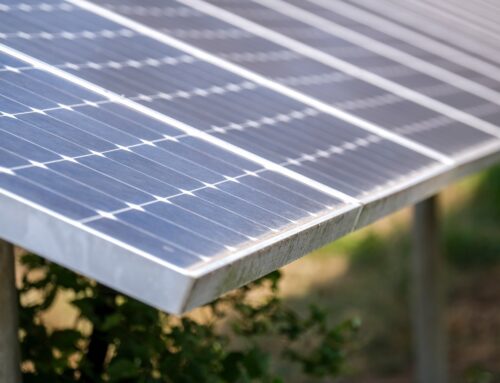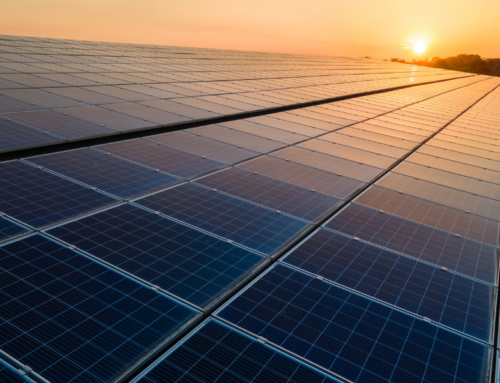Colorado utilities are trying to go green. Tariffs and geopolitical chaos are getting in t
April 8, 2025
Colorado electricity utilities — from the largest investor-owned corporation to rural electric cooperatives — are straining to meet reliability standards and state clean energy mandates as they face cost-spiraling economics and the threat of tariffs.
Xcel Energy, the state’s largest electricity provider serving 1.6 million customers, had to seek price relief from the Colorado Public Utilities Commission for its planned acquisition of new generation due to “changing market dynamics and geopolitical uncertainties.”
In February, Xcel filed a letter with the PUC expressing its “concerns about the continued skepticism around the level of resources we have identified as necessary to maintain the reliability of the current system and address the growing demand in Colorado.”
“Moving quickly and decisively to ensure we are building, or causing to be built, sufficient generation resources to meet future resource adequacy is paramount,” Xcel Energy told the commission.
The La Plata Electric Association, a co-op serving 49,000 residences and businesses in La Plata and Archuleta counties, has a wholesale power purchase deal that will help lower customer rates in the short run. The long run, however, is uncertain, according to Chris Hansen, the co-op CEO.
“There is absolutely upward pressure, and much of that pressure is by design from tariffs and the uncertainty around the Inflation Reduction Act,” said Hansen, who as a state legislator was one of the main sponsors on electricity reforms and clean energy mandates.
“It is a clear policy decision of the (Trump) administration to drive up prices for the wind, solar and storage,” Hansen said.
“These tariffs are very disruptive to the industry and exacerbate cost increases we’ve seen over the last five or six years,” Hansen said.
After seeing the cost of agreements to purchase wind rise 60% higher than anticipated and solar purchase power agreements up 50%, Colorado Springs Utilities told state officials it is facing cost and reliability challenges in meeting mandated greenhouse gas reductions.
The state’s utilities have a target of cutting emissions 80% over 2005 levels by 2030. The Colorado Energy Office said the sector is on target to meet the 2030 goals.
Colorado Springs Utilities — which was seeking 1,500 megawatts of new generation and 200 MW of battery storage and received 200 bids — is proposing several alternatives, including keeping the coal-fired Ray D. Nixon power plant, which is slated to close by 2030, running a little longer.
“We’re discussing alternative pathways with state policy makers to meet the current emission reduction standards,” Steve Berry, a Colorado Springs Utilities spokesperson, said in an email. “Those discussions are ongoing.”

Amid all these stressors, the Colorado Energy Office floated a 60-page draft of a bill, for the end of the current legislative session, that would have moved the deadline for 100% clean power generation with zero emissions to 2040 from 2050.
By the energy office’s own estimate, moving the deadline would have created $8.5 billion in costs.
In an indication of how fraught the market is, a letter — signed by 64 utilities, unions, public officials and business groups — was sent to legislative leaders and Gov. Jared Polis opposing introduction of the bill.
The signatories included the Colorado Chamber of Commerce, unions representing electrical workers and pipefitters, more than a dozen rural electric cooperatives, co-op power wholesaler Tri-State Generation and Transmission Association and Xcel Energy.
“This draft seriously risks driving energy costs higher at a time when our state is already nearing an affordability crisis,” the letter said. “We need time and space for discussions about the new era in power demand, cost, reliability, just transition.”
One concern, Hansen said, was the inclusion of cost caps in the face of market pressures. The La Plata co-op was a signatory.
“This is just the beginning of the conversation and we look forward to conversations around how Colorado can continue leading the nation on reliability, cost savings on electricity, and climate action,” Shelby Weiman, a Polis spokesperson, said in a statement.
There are three elements to the pressures Colorado utilities are facing: market economics, regulatory hurdles and changing policy.
“The global market for components for generation and transmission has been in turmoil since COVID and it keeps on coming,” said Mark Detsky, an attorney for the Colorado Independent Energy Association.
The association represents merchant power producers, who bid on projects for utilities, build power plants and sell their electricity in long-term fixed contracts. The problem the independents are having is holding to their bid prices over the long negotiating process with utilities.
The COVID pandemic, which scrambled supply chains and made obtaining key equipment difficult, was followed by a surge in inflation and now the threat of tariffs.
The U.S., for example, is now facing an “unprecedented” shortage of electric distribution transformers, creating challenges for utilities across the country, according to a study by the National Renewable Energy Research Laboratory.
The waiting time for transformers — the link between the high-voltage electricity from power plants and the stepped-down voltage that flows into homes and businesses — is now two years, four times the pre-2022 lead time, NREL said. Prices have increased by as much as ninefold.
For Xcel Energy’s electric resource plan or ERP, merchant developers made their bids two years ago. “They are negotiating and watching their costs tick up every day. It is a really hard business to be in right now,” Detsky said.
“These problems cut across the whole globe,” Detsky said. “You want a transformer for your project in Colorado? So do 500 other projects around the world.”

The second problem is the cumbersome process used to plan and obtain new electric infrastructure, especially for utilities like Xcel Energy, which is a regulated monopoly.
Customers in its service territory have no option other than to buy their electricity from Xcel. The role of the PUC is to oversee the utility to make sure its expenses are prudent and necessary and that the service is reliable and reasonably priced.
This creates a long review process for energy plans and rate increases. Xcel Energy first proposed its Clean Energy Plan in 2021, then revised it — greatly increasing its scope and cost to $12 billion — in 2023.
First the commission approved Xcel Energy’s plan, though it delayed $3 billion in projects to a later date. Xcel then was able to issue a call for bids.
By July of 2024, however, the company was back at the commission saying that due to the market the price tag on the plan would have to rise.
“It looks like they are contemplating price and cost increases, which causes me a lot of concern,” PUC Chairman Eric Blank said at the time. “I am really nervous about what is going on here.”
In December, the commission agreed to permit a cushion of an extra 5% on wind projects and 1% on solar projects. Even with that, Detsky said, no contracts have yet been signed.
“The numbers we are seeing in the projects are nowhere near the numbers we used in planning,” said Joseph Pereira, deputy director of the Colorado Office of the Utility Consumer Advocate. “Price, system reliability, clean energy goals are all pulling at the process.”

In its letter to the PUC, Xcel said “the resource planning process is proving too inflexible to meet needs in a dynamic environment.”
The PUC, in a statement to The Sun, noted that part of the length in the process was due to Xcel Energy changing its original plan.
“While we recognize, and to some extent agree, with Xcel Energy’s concern about the pace of the ERP process, the final outcome in this case is a landmark decision establishing new optionality and flexibility which propels Xcel towards an 86% reduction in emissions by 2030,” the commission said.
“The PUC’s role is to balance safety, reliability, affordability, and clean energy in every proceeding,” the commission said. “We’ve continued to deliver on this mission in the face of a substantially increased workload resulting from recent legislation and utility filings.”
Compounding all these problems is a projected surge in demand for electricity as data centers are built, the number of electric vehicles grow, buildings switch from gas to electric heating and other industrial processes go electric.
Xcel Energy is forecasting an annual 5% growth in electric load through 2031 compared with nearly flat demand during the past five years. The Colorado Energy Office projects a 50% increase in electricity demand for the state by 2040.
Facing these demands, Xcel Energy said it will need a third “thermal asset” — a natural gas-fired plant — in its plan to ensure reliability.
The other element needed is more transmission to link new generating capacity to population centers and other utilities to help bolster wholesale power markets. “The biggest thing we need is certainty in transmission,” Detsky said. “There is no transmission to match the generation” proposed by utilities.
It is increasingly difficult to build both transmission and generation. Barely half the new generation scheduled to come online in the West in 2023 went into service with the rest delayed or canceled, according to the West Electric Coordinating Council.
“The key is siting, can we get stuff built in a timely fashion, can we site things,” Hansen said. “We’ve got to come together and decide how we are going to get things built.”
The third element roiling the electricity market is government policy at both the state and federal level. Utilities already have to meet state greenhouse gas reduction targets. The idea of moving those targets prompted a strong pushback.
☀️ READ MORE
At the federal level there is great uncertainty. The Biden administration’s Inflation Reduction Act provided a number of clean energy grants, loans and tax credits to utilities and merchant power developers.
About $3.2 billion of those funds was released to Tri-State and six Colorado cooperatives after a two-month freeze, but the fate of others, particularly the tax credits that are crucial to the market economics for merchant power producers, remain in limbo.
Then last week President Donald Trump called for sweeping, worldwide tariffs. But even before the announcement, the tariffs made themselves felt.
“Although these proposed tariffs and policy changes have yet to have full effect, vendors have preemptively included the anticipated increases in their pricing models,” Colorado Springs Utilities CEO Travas Deal said in a February blog post.
Much of the electronic equipment used to build the electric grid is imported. About 80% of those hard-to-get transformers are imported, with Mexico and China the biggest suppliers.
“This is a difficult environment,” said Robin Lunt, chief strategy officer at Guzman Energy, a power wholesaler and renewable energy developer. “There are a lot of moving parts.”
“Market volatility makes it harder to make investments and decisions,” Lunt said. “The price of wind and solar is going up. First it was inflation and then supply chain and now uncertainty. … Uncertainty increases prices.”
Search
RECENT PRESS RELEASES
Related Post




